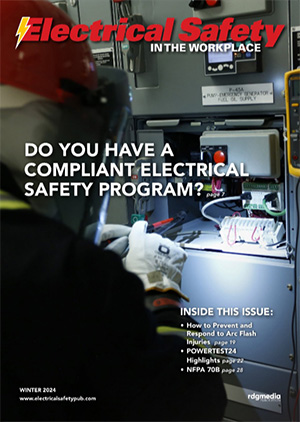How to Prevent and Respond to Arc Flash Injuries
Boundaries, PPE, training and proper victim care can save lives.
Contributed by: Medshop

In 1979, the National Fire Protection Association (NFPA) established the standard for workplace electrical safety, NFPA 70E. © Pog – stock.adobe.com.
For the past four decades, working with electricity has become safer in the United States. Ever since the National Fire Protection Association (NFPA)1 introduced its NFPA 70E® Standard for Electrical Safety in the Workplace, the number of fatalities and less serious injuries has dropped.
However, despite this declining trend, electrical contractors, electricians, and other workers in the sector continue to be injured at work. The Bureau of Labor Statistics (BLS)2 reports that more than 7,200 electricians suffered an injury or illness that required days away from work in 2016-2020.
In fact, employees in any occupation can be injured by exposure to electricity. Exposure to electricity caused 145 fatal occupational injuries3 in 2022, and 2,950 non-fatal occupational injuries4 in 2021-2022 according to the most recent BLS reports.
Arc flash injuries are one of the causes of some of the more severe injuries. In this article, we examine how to respond effectively to arc flash injuries at work and provide appropriate first aid.
WHAT IS AN ARC FLASH?
The Occupational Safety and Health Administration (OSHA) defines an arc flash as a phenomenon during which a “flashover” of electric current strays from the path it’s meant to follow. It then moves through the air to another conductor or to the ground.
An arc flash can result from several causes, including the following:
- Dust
- Dropped tools
- Accidental contact
- Condensation
- Material malfunctions
- Corrosion
- Incorrect installation
Regardless of the cause, arc flashes often cause severe injuries to nearby employees.
ARC FLASH INJURIES: CAUSES AND IMPACT
The severity of an arc flash injury depends on several factors, including how close a worker is to the hazard, the temperature and the amount of time it takes for the circuit to break.
The following are some of the most common injuries associated with arc flashes:
- Burns caused by fires and exposure to temperatures above 35,000 degrees Fahrenheit.
- Musculoskeletal injuries caused by flying objects striking a worker.
- Brain injuries and concussions caused when a worker falls and hits their head or gets hit in the head with a flying object.
- Hearing damage caused by sound blasts that reach up to 140 decibels.
- Vision damage caused by exposure to ultraviolet light.
These injuries are severe and can even be fatal. They often cause permanent changes to employees’ quality of life; some require expensive medical care exceeding $1 million.
WHAT TO DO AFTER AN ARC FLASH INJURY OCCURS
If an arc flash injury does affect an employee, it’s essential that everyone knows what to do and acts as quickly as possible. Employees are more likely to suffer permanent damage or death if treatment is delayed.
These steps can help to mitigate the damage caused by arc flashes:
- Do not touch the affected person.
- Shut off the power.
- Contact emergency services immediately.
- If the victim is on fire, attempt to smother flames — do not try to remove the victim’s clothing, especially if it has melted to the skin.
- Do not tell or let the affected person move; this could worsen injuries or cause new ones.
- If the victim is not breathing or does not have a pulse, start CPR while waiting for emergency personnel to arrive.
- Run cool (but not cold) water over the victim’s burns.
- Do not apply ice, cream, or ointment to the burns.
- When the burn has cooled, cover it with a clean, dry cloth.
Don’t give victims food or water. Make sure they receive medical attention right away, even if they insist that they feel fine.
Sometimes, the effects of an arc flash incident aren’t apparent immediately. Failure to seek medical care immediately could lead to more severe injuries and long-term damage. It is crucial for employers to ensure that a well-stocked first aid kit is readily available in the workplace to ensure immediate access to essential medical supplies and resources.
HOW TO PREVENT ARC FLASH INJURIES
An electrical safety program and safety training for all employees, regardless of their role, can prevent arc flash injuries. According to the Occupational Safety and Health Administration (OSHA), an arc flash risk assessment should be used to investigate workers’ potential for exposure to arc flash energy. This information is used to determine appropriate safe work practices, boundaries, and personal protective equipment (PPE) based on:
Arc Flash Boundary: When the potential for an arc flash hazard exists, an arc flash boundary is an approach limit at a distance from a prospective arc source within which a person could receive a second degree burn if an electrical arc flash were to occur. A second degree burn is possible if unprotected skin is exposed to an electric arc flash with an incident energy level above 5 J/cm2 (1.2 cal/cm2).
Limited Approach Boundary: An approach limit at a distance from an exposed energized electrical conductor or circuit part within which a shock hazard exists.
Restricted Approach Boundary: An approach limit at a distance from an exposed energized electrical conductor or circuit part within which there is an increased likelihood for electric shock, due to electrical arc-over combined with inadvertent movement.
In addition to training employees on the different boundaries and the risks associated with each one, employers can take additional measures to protect their teams, including the following:
- De-energizing circuits
- Placing guards and barricades around dangerous equipment
- Implementing Ground Fault Circuit Interrupters (GFCI)
- Using grounding as secondary protection
ADEQUATE INFORMATION AND TRAINING
Employees should also have access to training and tools that increase their safety while on the job.
For example, the only employees working with energized electrical equipment should be those with special Energized Electrical Work Permits. Their job briefings should also include information about the types of equipment they will work with and the risks associated with that equipment so they can make informed decisions about whether or not the job is for them.
Ongoing training also reduces the risk of arc flash injuries. Employees at risk of arc flash exposure should undergo an in-depth, written training program explaining the dangers of the job and the proper protocols for staying safe (and keeping their coworkers safe).
Exams and assessments will help employers to ensure team members understand the safety rules and how to follow them.
PERSONAL PROTECTIVE EQUIPMENT
Employers must provide employees with sufficient personal protective equipment (PPE) as well. These items are some of the most commonly distributed:
- Protective clothing (long sleeve shirts, long pants, and coveralls) made from non-melting material or untreated natural fibers
- Face shields
- Safety glasses or goggles
- Hearing protection
- Rubber-insulated or heavy-duty leather gloves
- Hard hats
- Leather footwear
Insulated tools can also help to mitigate the chance of severe arc flash injuries.
FINAL THOUGHTS
Arc flash injuries are serious and can cause lasting damage to employees who work on or near energized electrical equipment. Employers should utilize the guidelines discussed above to respond to injuries correctly and provide adequate victim care.
About the Contributor
Medshop is a global leader in medical supplies and services. Established in 2005 in Melbourne, Australia, Medshop began its journey catering to nursing students and allied health professionals. Today, we are proud to serve a diverse clientele, including government agencies, hospitals, universities, private practices and the general public, spanning across multiple countries. Visit www.medshop.com.au
Sources
2 https://www.bls.gov/iif/snapshots/osn-electricians-2016-20.htm
3 https://www.bls.gov/news.release/cfoi.t02.htm
4 https://www.bls.gov/iif/nonfatal-injuries-and-illnesses-tables.htm#cd
Share on Socials!
How to Respond to Arc Flash Injuries with Proper Victim Care
How to Choose the Right Electrical Gloves for the Task at Hand
Six Electrical Safety Tips for Construction Workers
Leaders in Electrical Safety
• Aramark
• Bowtie Engineering
• Enespro
• Ericson
• I-Gard Corporation
• IRISS
• KERMEL, INC.
• Lakeland Industries
• MELTRIC Corporation
• National Safety Apparel
• National Technology Transfer
• Oberon
• Saf-T-Gard
• SEAM Group
Subscribe!
Sign up to receive our industry publications for FREE!







